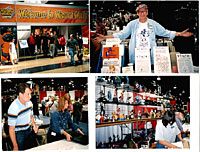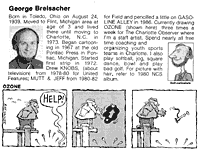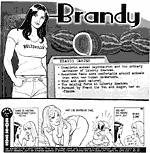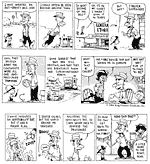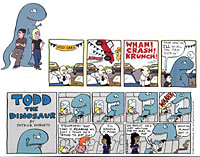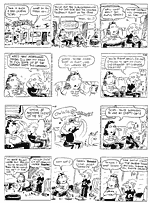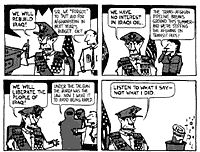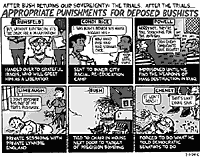 |
|
|
Opus 144: Opus
144 (August 31, 2004): At the
end this time, our feature on the perils of being Ted Rall if you're
a cartoonist commentator and don't like the Bush League (or of being
in the Bush League when Ted Rall is taking aim), with an aside on the
abuse of the Internet by pressure groups leveling scads of e-mails at
the objects of their detestation. Between here and there, a correction
about Ronin Ro's book on Jack Kirby, Tales
to Astonish, and news about the forthcoming new Schulz book, Zippy
on stage in San Francisco, the Festival of Cartoon Art, the Buffalo
News replacement (at long last) of Tom Toles, a report on Wizard
World and the graceful Terry and Rachel Dodson, a new collection of
Lola, and the Christian invasion of Hollywood and the entertainment
realms. Without further adieu, we begin forthwith with a- CORRECTION. Recently, in Opus 142, I announced the arrival of
a new tome, Tales to Astonish,
which, I said, was another version of the creative relationship between Stan Lee and Jack Kirby. This one, by Ronin Ro (Boomsbury, 296 pp., $24.95), reportedly,
I said (repeating what I'd read somewhere, as is often my wont), reduces
Kirby's role while elevating that of Lee, "a marketing genius,"
the reviewer opined, "who overshadowed Kirby as his boss and most
famous collaborator." Ro subsequently wrote me to correct this
statement, saying that his purpose in the book was actually nearly the
complete opposite of what the alleged reviewer reported. (And it's possible
that I misconstrued the reviewer's remarks: they could very well apply
to the popular opinion of Lee rather than the reviewer's or Ro's.) I've
now browsed rather thoroughly through Ro's book and I must agree: his
narrative deals extensively with the Kirby-Lee collaboration and gives
Kirby the lion's share of credit for creating the Marvel Universe, focusing
on his career more than on Lee's. By Ro's account, Kirby was almost
routinely snubbed in the publicity surrounding the success of the Marvel
revolution while Lee was championed. Lee, whom Ro interviewed for this
book, regrets this circumstance but claims to have had little to do
with it: he can't help, he says, how reporters write their stories about
Marvel Comics. The story of the Marvel revolution is a fascinating one,
and Ro's prose is lively reading. The book, however, lacks any trace
of scholarly apparatus (footnotes, bibliography-any sort of systematic
attribution of facts to Ro's sources). Ro lists the people he interviewed
for the book and the books and magazine articles he consulted. But his
text is laced with direct quotations from various people, and the sources
for these quotations are nowhere given. We must assume they all come
from his interviews although I recognize at least one of Lee's statements
as having appeared elsewhere. Whatever his enthusiasm for this task,
Ro is apparently not a student of the comics, a situation that forces
him to rely upon the testimony of his witnesses, and either he or they
are sometimes wrong. Billy Batson, who became Fawcett's Captain Marvel
by shouting "Shazam," is not a crippled newsboy; that was
Freddie Freeman, who became Captain Marvel, Jr. And Ro repeats the canard
about Lee's having won a newspaper-sponsored writing contest three times
running while a teenager (a claim that the Stan Lee biography by Tom
Spurgeon and Jordan Raphael dispells). These two circumstances-the absence
of systematic sourcing and the occasional outright error-may induce
the reader to be wary of some of Ro's more revelatory statements. Still,
everything I read seemed of-a-piece with the known history of the Marvel
revolution and the personalities involved, and several statements attributed
to Roy Thomas about Lee's role in inventing, say, the Fantastic Four
dove-tail perfectly with statements in Spurgeon-Raphael. In the last
analysis, most books about comics and their creators are, like Ro's,
weak in documentation. Spurgeon-Raphael's book, while lacking footnotes,
cites sources, chapter by chapter, listing interviews and books and
magazines, albeit without citing page numbers in the latter; it has
much more the aura of a book based upon facts rather than fictions.
It's too bad Ro didn't do the same, although, as I say, most of what
I read in his book jibes with everything I know about the people involved.
Probably worth adding to your bookshelf; I'm getting one for mine. NOUS R US You read it here last time-the forthcoming reprint of
Charles Schulz's single-panel
newspaper gag cartoon about sports, It's
Only a Game. And you read it here first. It was a scoop, kimo sabe:
to the best of my knowledge, no other news medium had that story on
the air then. And now that the book mock-up has been given final approval
by Jean Schulz, it's on its way to the printer and, by November, your
local comics shop. It's also offered in this month's Previews. The cartoon
series, by the way, is not only a "long lost" specimen of
Schulz's work: it's also the only syndicated material her produced with
adults as the principal characters. For most Schulz fans, it'll be the
first time they'll see how the celebrated cartoonist rendered grown-ups.
It's Only a Game would seem to be a natural outgrowth of Schulz's
abiding interest in sports-skating, hockey, baseball, football. Publisher
Nate Gertler (About Comics) said of the cartoon: "Schulz focused
mainly on participation sports and games, so there are strips about
bowling, bridge, and fishing as well as the big team sports. In fact,
it's rather amazing how broad a range of topics is covered. Over the
course of 255 cartoons, the series covers everything from Monopoly to
rodeo." After the initial weeks of the series, Schulz produced
only rough pencil sketches for the cartoons, turning the remaining drawing
chores over to Jim Sasseville, who carefully aped Schulz's style for
the run of the feature, and Sasseville has provided Gertler with an
assortment of special visuals, including roughs that were never used.
Sasseville also supplies the book's running commentary. This'll be a
treasure-240 5.5x6.5-inch black-and-white pages in paperback, $14.95. The
Buffalo News, which lost its editorial
cartoonist Tom Toles to the
Washington Post two years ago, has finally
hired a staff cartoonist. Since the paper dawdled so long, it was long
suspected among editorial cartoonists that Toles wouldn't be replaced,
that the paper would seize the opportunity to save the cost of salary
and benefits. The paper's management did little to unhorse the rumor.
But now it has. The new guy is Adam
Zyglis, a genuine newcomer to the profession. Just 21 years old
and a fresh (May) graduate from Canisius College with a major in computer
science and a minor in math, Zyglis has been interning at the News
for the past three months as an illustrator. His present assignment
is to do three illustrations and two editorial cartoons a week, with
the expectation that he'll gradually draw more cartoons and fewer illustrations
over the next few years. The News
obviously intends to bring him along slowly, perhaps because they want
to foster in him a political attitude compatible with the newspaper's
prevailing posture; otherwise, they might have hired a more experienced
editooner who would have come to the paper with fully developed editorial
attitudes. Nothing wrong with the paper's plan; in fact, it's admirable.
Nothing makes for a cartoonist having a short career at a newspaper
faster than political incompatibility; the News clearly wants to keep this guy on board. And it's encouraging
that the paper values editorial cartooning enough to have its own staff
'toonist. Too bad, though, that veteran cartoonists out there are still
looking for employment while the News
launches a near-novice on a career that, for many of his brethren, is
fading fast as newspapers across the country dismiss their staff cartoonists
and resort to syndicated material. On the other hand, Zyglis is a fresh
face and pen on editorial pages, and that would seem to signal that
editorial cartoonists are not, really, an endangered species, the present
dwindling roster notwithstanding. In drawing style, Zyglis is closer
to David Horsey than to Jeff
MacNelly, and he appears to be shading with a pencil in the manner
made so stunningly effective by Steve
Sack at the Minneapolis Star-Tribune.
Samples at www.adamzyglis.com
Wizard World, the current incarnation
of the beloved old Chicago Comic-con of yesteryear, says it drew 54,500
attendees over its three-day show, August 13-15, in the Rosemont Convention
Center. That's about half what the Sandy Eggo folks say attended their
July 21-15 blow-out: their "unofficial" tally, reported by
Time.comix Andrew Arnold, stands at 100,000, representing a 30% increase
over last year's attendance. While the California extravaganza may be
characterized as comic books overwhelmed by Hollywood ("an overpowering
presence of the film industry" according to Michael Sangiacomo
at The Cleveland Plain Dealer), the Chicago event may be said to be comic
books invaded by toys and action figurines. Toys were also evident in
abundance in San Diego, of course, but Hollywood wasn't anywhere obvious
in the Windy City. As an convention for Golden Age comic book fans,
the Chicago con has a higher percentage of comic book dealers, seems
to me; but since the show is smaller than the San Diego pachyderm, the
actual number of comic book dealers is probably about the same in each
place (although the dealers are somewhat different from place to place).
Wizard World is clearly the smaller of the two cons: it could fit into
one of the eight halls at the San Diego Convention Center. But the Wizard
folks give more space to practitioners: the Artists Alley in that toddlin'
town is at least half-again as large as the San Diego equivalent. I
had a table in Chicago but not in San Diego; I sold some books and monographs,
but none of you with Charter Rabbit Fete cards showed up to claim a
discount. Sigh. Yet
another museum is mounting on an exhibit of the cartooning arts. Entitled
"Snicker, Chuckle and CWAC!" the exhibit is organized by the
Central Washington Associated Cartoonists and features, mostly, their
work-Dan McConnell, John Barnes, Anthony V. Talbot, Les Garcia, Frank
Gonzales, Erin Hudson, Dean Ball, Melissa Hudson, Susan Freiberg, and
T Lewis (the only nationally syndicated cartoonist in the lot, Lewis
draws Over the Hedge in a deft and delightful manner). Also on display will
be original art by such 20th century masters as Walt Kelly (Pogo), Charles Addams (The New Yorker), Jeff MacNelly (editoonist and creator of the comic strip, Shoe), and two comic book creators, Arthur Adams and Al Milgrom (the team currently producing one of the X-Men titles
for Marvel). The show will run through January 21, 2005, at the Wenatchee
Valley Museum, 127 S. Mission in Wenatchee, Washington (east of the
Cascade Mountains on the Columbia River). Garry Trudeau has signed Phoenix Pictures
and Walden Media to write an original screenplay about a boy who becomes
mayor of a small town. The story is loosely based up the experiences
of two real-life teenage mayors of small towns; Trudeau is working with
both of them in crafting his tale. ... Stephen Sommers and his "Van
Helsing" producing partner Bob Ducsay have acquired the rights
to Flash Gordon, the iconic 1934 space opera creation of Alex Raymond. And Flash is slated to be
revived in the four-color print format, too, at Top Cow. ... Howard
Stern is getting into cartoons, the animated variety, with a 13-episode
series "Howard Stern: The High School Years" ordered by the
male-oriented cable tv channel, Spike TV; the shock jock's parents,
frequent call-in guests on his radio show, will be "major characters"
in the cartoon series. ... Donald
Duck, who celebrated his 70th birthday on June 9, recently
achieved Tinseltown's grandest distinction-a star on the Hollywood Walk
of Fame. His star, the 2,257th, is just outside El Capitan
Theatre on Hollywood Boulevard. Mickey Mouse, Pluto, and Daisy Duck
showed up for the ceremony on Monday, August 9. And
in San Francisco at the Dark Room, a new community theater venue, "Zippy
the Pinhead in Fun: The Concept" concluded a month-long run recently.
The stage version, written by playwright Denzil Meyers (who took about
75 percent of the dialogue direct from Bill
Griffith's comic strip), focused on the relationship between Griffith's
alter ego in the strip, "Griffy," and the Pinhead. Playing
against Zippy's worship of American consumerism is Griffy's intense
dislike of it (despite his participation in it). Meyers interspersed
through the material he imported from the strip enough connective tissue
to create a narrative-but very carefully. "You can't out-Zippy
Zippy," he said. "I was very conscious of having the staging
and rhythm feel like [the] strip while still advancing a longer plot
thread. It was a challenge since 70 minutes of non-sequitur wouldn't
be very good theater, but too much sense wouldn't be true to the strip.
If no one leaves the theater either angry or confused, we haven't done
our job." At
the Comic Book Legal Defense Fund, its founder, Denis Kitchen, retired in July, and Chris Staros, publisher of Top Shelf, was elected President. Staros
has been on the Board of Directors for two years. Kitchen retired, he
said, because comics are now facing different challenges than they had
to face when he launched CBLDF: "I think it's fitting that the
generation directly facing these challenges, led by Chris Staros, a
publisher after my own heart, should be the ones standing up to them."
He expects to continue to support the Fund "from the other side
of the table," and he remains confident about the health and future
of CBLDF. Every
three years, the Cartoon Research Library at Ohio State University sponsors
a Festival of Cartoon Art. During the two-day
celebration, some of the nation's foremost cartoonists parade before
the audience in a series of hour-long presentations. This is another
of those "third years," and October 15-16 is the time. The
theme, "Deletions, Omissions and Erasures," hovers around
the censorship and controversy comics have seemed to provoke over the
years, but particularly in recent times. This year's speaking roster
includes: Nicole Hollander (Sylvia),
Tom Batiuk (Funky Winkerbean and Crankshaft),
Al Feldstein (Mad), Michelle Urry (cartoon
editor at Playboy), Charles Brownstein (executive director,
Comic Book Legal Defense Fund), Mike
Ramirez (editorial cartoonist, Los
Angeles Times), Cindy McCreery
(author of Genius on the Edge:
James Gillray), Jay Lynch
(underground cartoonist, Bijou Funnies), Bob Levin (author of The Pirates
and the Mouse: Disney's War against the Counterculture), Tom Tomorrow (This Modern World), Lalo Alcaraz
(La Cucaracha and editoons),
Ann Telnaes (editorial cartoonist
and one of six women producing the strip, Six Chix, in rotation), Joel
Pett (editoonist at the Lexington
Herald Leader), and Art Spiegelman
(Maus and, impending, In the Shadow of No Towers). A stellar
line-up. For registration information (and participation is limited
to the first 275 applicants), visit http://www.lib.ohio-state.edu/cgaweb Sadly,
we report that George Breisacher
died August 11 of a heart attack suffered at his home in Charlotte,
North Carolina. His death was, as they say, "unexpected"-which
usually means he was both too young and apparently too healthy to die.
He was only 65 and a runner. He will be mourned by many and missed by
many more. George was editor of the National Cartoonists Society newsletter
for ten years (1987-97) and then twice president of the Society, bringing
to that office his considerable knowledge of the workings of the group
(acquired as newsletter editor) and a profound respect for NCS traditions,
which he'd participated in since 1974. He had retired in 2001 from his
position as illustrator/cartoonist at the Charlotte Observer, where he'd worked since
1973. He was what I'd call a "journeyman cartoonist"-he worked
at whatever was needed. And he was good at it, an exemplar of the breed.
According to a fellow Charlotte resident, Marcus
Hamilton, who now draws the daily Dennis
the Menace cartoon: "He could take any assignment that the
Observer gave him, and he could adapt his
style to whatever the assignment was." Here's what George said
about himself in one of the editions of the NCS
Album (a directory of the membership): Anniversaries.
The
Pink Panther turns 40 this year. The jaunty feline first appeared in
the lengthy seven-and-a-half minute opening segment of the Blake Edwards
movie of the same name, the result of a collaboration between Friz Freleng and David DePatie.
Given the ensuing appearances of the cat in 172 7-minute animated shorts,
it is surely pardonable if many movie-goers think that "Pink Panther"
is the name of a character. And so it is: the animated panther is, now,
the Pink Panther. But the animated cat was initially intended merely
to enliven the opening credits of the movie, which is named for a fabulously
valuable diamond with a rare pink amber at the center that looks like
a leaping panther. ... Buster
Brown shoes is 100 years old this year. Brown Shoes introduced a
kids line of footwear at the St. Louis World's Fair, licensing the name
of the comic strip character Richard Outcault had introduced in 1902.
Over several generations' worth of publicity, an enduring slogan evolved:
after a dog's bark, Buster says, "That's my dog Tige. He lives
in a shoe. I'm Buster Brown. Look for me in there, too." It rings
in my head still. Said Buster Brown Director Maureen McCann: "Since
our beginning, Buster Brown has been about reaching kids through television
shows, advertising, gifts-with-purchase, and live receptions. With this
anniversary, we are returning to our roots, focusing the next 100 years
on being a fun brand for kids. We want to give today'[s kids the same
enjoyment that a boy named Buster Brown and his dog Tige gave their
parents when they were children." To this purpose, doubtless, the
company recently signed a licensing agreement with Disney to employ
Mickey Mouse and Minnie and the whole gang, including such classic film
stars as Bambi and the Lady and the Tramp, in new lines of shoes for
kids that will launch into retail in the spring of 2005. "We are
thrilled to be developing this alliance with Disney," said Wholesale
President Gary Rich. "Disney's beloved characters add their own
special magic to children's feet." The combination of the "number
one global consumer products company" (Disney) with Brown Shoe's
"strength," will, Rich says, add "new excitement to the
children's footwear marketplace." That's what we all need: more
excitement on our feet. Brown is a $1.8 billion footwear company, operating
a 900-store Famous Footwear chain and nearly 400 Naturalizer stores
in the U.S. and Canada. In addition to such brands as LifeStride, Connie
and Buster Brown, the company has Barbie, Superman, Supergirl, Looney
Tunes, and AstroBoy character footwear for children. More excitement
than you can shake a shoe horn at. Funnybook Fan
Fare Frank Cho's Liberty
Meadows comic book from Image is on the cusp of the 37th
issue, whereupon it will begin to print new material, having run through,
in the previous 36 issues, the strips that first saw the light of day
in newspaper syndication. (Most of them were reprints; some had been
censored by the syndicate so their comic book appearance was their debut
in print.) Before getting into the new stuff, Cho has apparently decided
to make sure we all know who's who and what's what in the strip to-date,
hence- Liberty Meadows Sourcebook. Cho prefaces its content with this: "I
can't think of a comic book creator that hasn't looked at the New Strips Two new ones from King Features. In the first, Franklin Fibbs, we meet a world-class "embellisher"
of fact, the Baron Munchausen of the comics, a teller of tall tales,
some of which he stars in and some of which, for the sake of his own
humanity, he is the butt of. Fibbs is a somewhat crusty storekeeper
who sustains his life and that of his bemused wife, Paloma, by means
of a general store somewhere in a desert in the Southwest where her
Hispanic ancestry is wholly at home. While she occasionally questions
the authenticity of her husband's accounts with an arched eyebrow, a
neighbor kid, Josh, urges the prevaricateur on by simply indulging his
own curiosity. The strip has one of those double-barreled authorships:
written by Hollis Brown, who says Franklin Fibbs is "based on a boss I once
had at a dance studio in North Hollywood [who spent] most of the day
going on about his life and the glory days of old Hollywood," the
strip is crisply and cleanly drawn with a fragile, scratchy line by
Wes Hargis, who got into the business when the editor of a Tucson
newspaper invited him to do editorial cartoons. "I'd love it if
more editors took a chance like that with local talent," he said. The other newcomer at King is the much more simply rendered Todd the Dinosaur, written by Patrick Roberts and drawn by Bob Condron. Todd, unlikely as it seems, is an actual seven-year-old, 12-foot-high 3-ton tyrannosaurus rex who has been adopted by a mid-level insurance executive with the highly amusing name Trent Footbridge. The other regular member of the cast is Susie, Trent's girlfriend, who has been dating Trent for three years and whose name isn't funny in the least. Todd is attending second grade in elementary school, where he is treated pretty much like any other seven-year-old except that he must sit in the back of the classroom because if he sat anywhere else, no other pupil could see the blackboard. Roberts worked as a tech writer for sixteen years before deciding his doodles of a dinosaur looked funny enough to be cartoons. The strip is a dream come true: "When I was a kid," Roberts said, "I may not have thought that I was destined to be a cartoonist, but I did think I was destined to grow up and be a dinosaur." Don't we all. Condron worked as a sports cartoonist for the Pittsburgh Post-Gazette and freelanced editoons and magazine cartoons; when not cartooning, he works full-time as a job coach for people with disabilities. And
from United Feature, here's Silo
Roberts, a day-by-day chronicle of a multi-ethnic kid trying to
find his place in a melting pot world. And if that's not enough demographic
niche pandering, Silo is a middle child living in a single-parent household
with his mother (a professional journalist), his older brother (an overweening
jock who is more successful with the girls than Silo is), and his touch,
animal-loving sister. The strip's creator is Rob
Cabrera, a bilingual (English and Spanish) elementary school teacher
in South Florida. Multi-ethnic himself, Cabrera says the idea for Silo
came to him while he was in high school: "From the first doodle,"
he said, "I knew this kid had a story. And although he's loosely
based on me, he's truly his own character. He's a lot braver than I
was." In a country in which nearly seven million citizens classify
themselves as belonging to more than one race, and more than 25% are
non-white, Silo is a typical kid of the 21st century, according
to the syndicate press release. Cabrera toured the country during his
college days as a stand-up comedian but came to realize his brand of
humor works best in a comic strip. When not trying out new routines
on his students these days, he lives in an apartment-studio he calls
"The Batcave." Finally,
from Universal Press comes Mullets,
a comic strip about "dumb and dumber." A "mullet,"
I discover, is a hair style-shoulder-length in the back, short in the
front-that declares "business in the front, party in the back."
The hairdo made famous by Mel Gibson in one of those "Lethal Weapon"
movies maybe; or maybe it was one of the professional wrestlers. Sometimes,
it's called "mudflap." The strip was launched last fall, late,
so it is not, strictly speaking, a "new" strip. But it's newer
than, say, Popeye. Mostly, Mullets is about two misbegotten young dolts, Kevin Mildew and his
buddy and fellow ignoramus, Scab. They work in Kevin's father's hardware
store, where they often encounter the parentus
bossofus himself (a man who, we are told, is "haunted by the
certain knowledge that all he has worked for so hard to build will one
day be Kevin's") or Britney, "the goddess of Register Three
and object of Scab's unrequited love." The dull duo are forever
doing colossally hebetudinous things, as we can see from the accompanying
sample. REPRINTS Lola is back. An
American Idle: A Lola Collection finds the laser-tongued, cigar-chomping,
politically incorrect grannie back between two covers (128 8.5x11-inch
back-and-white pages in paperback; Andrews McMeel, $10.95) after a first
incarnation in newspapers in the strip written and drawn by both Steve Dickenson and Todd Clark: that's right, they both do
both. Adopting a modified (but not too much) "Drabble style,"
Dickenson does the Sundays; Clark, the dailies. Lola lives with her
son, who might be described as long-suffering but he goes with her on
a walk through the woods anyhow. "Ahhh," he sighs, "the
sights and sounds of nature ... What's your favorite part about nature,
Mom-seeing it or hearing it?" Lola says, "Not stepping in
it." Her
contact with the outside world is limited to shopping, the bench in
the park, and the occasional visitor on the front stoop. At the deli,
the counterman, seeing Lola and several other people standing and waiting
to be served, asks: "Okay-who's next?" When that produces
only confusion, he amends: "How about this-who's been here the
longest?" To which Lola has the only sensible reply: "On earth
or in the deli?" On
the bench in the park, Lola is often joined by another creaky member
of her generation. The old man next to her one day remarks, "We're
getting old, Lola ... I can remember when sex was safe and riding in
airplanes was dangerous." This one furnishes a vivid demonstration
of the importance of leaving publication data on the reprinted strips:
it was produced before 9/11, specifically for release on June 15, 2000.
The joke, after September 2001, wouldn't make sense. A man
conducting a survey door-to-door asks Lola: "What's your take on
gun control?" Lola says: "Not letting the perp see your trigger
finger tremble." Watching a tv-evangelist program that asks, "Have
you found God yet?" Lola reposits: "I didn't know she was
missing." And I thought Lola was politically incorrect. Guess not. Civilization's
Last Outpost According to the article in a recent issue of Time, Christians have discovered that movies
make good "parables" for teaching Christian values, and clergy
from sea to shining sea "have commandeered pulpits, publishing
houses and especially websites to spread the gospel of cinevangelism,"
said Richard Corliss. Just as Hollywood has suddenly realized, in the
wake of Mel Gibson's success with "The Passion of the Christ,"
that there's money in religion, so has the pastoral community recognized
the potential of movies for influencing their flocks and would-be flocks.
Peter Parker in "Spider-Man," for instance, "gives us
all a chance to be heroic," according to one Baptist pastor; but
instead of looking for radio-active spiders, we should realize that
"it's God who changes us." Well, I dunno that the movie imparts
that particular lesson. But preachers hope to reach young people via
the silver screen. Until recently, the Puritanical streak in American
morality saw movies as vaguely immoral. "Being Christian used to
mean you didn't go to Hollywood movies," according to David Bruce,
who operates the website www.hollywoodjesus.com
; "now it is seen as a missionary activity." More and more.
According to another source, only one film in 1985 had "positive
Christian content"; but in 2003, 69 fostered such sentiments. ...
The demand for spiritual relief has apparently exceeded the Catholic
church's ability to supply it in the U.S. A shortage of parish priests
has resulted in the outsourcing of paid requests for special prayers
for the dead, sick, and newborn. These prayers are now being prayed
by priests in India. One diocese responded to 350 requests for special
prayers and masses each month for a $5 fee each. VITUPERATIVE
CONTUMELY AND VITRIOLIC HYPERBOLE Ted Rall is, by now, firmly established as the nation's
favorite venomous cartoonist-commentator. The Wall Street Journal certifies him as "the most bitterly
anti-American commentator in America." And The National Review, another model of decorum and restraint, says
Rall is "a big fat zero, an ignorant, talentless hack with a flair
for recycling leftist pieties into snarky cartoons that inspire breakfast-table
chuckles among the leftist literati and the granola-munching types."
With recommendations like these, Rall scarcely needs me to celebrate
the appearance of his latest compendium from NBM, Generalissimo
El Busho: Essays & Cartoons on the Bush Years (208 6x9-inch
black-and-white pages in hardback, $19.95). But I can't think of a better
way to herald the Dubya coronation in New York than to applaud the timely
arrival of this volume. Generalissimo collects Rall's syndicated
columns and cartoons from September 2000 to January 2004, a period that
embraces the usurpation of the White House by the Bush League, the 9/11
tragedy, and the ensuing invasions of Afghanistan and Iraq-all of which
earn Rall's heartfelt opprobrium in both prose and picture. In
his Preface, Rall sets the mood. "My primary objections to a Dubya
presidency concerned its dynastic pretensions-Adamses and Roosevelts
aside, a nation with fewer than fifty presidents to its name ought to
be able to find its leaders in new families each and every time-and
the man's lack of intellectual qualifications. Simply put, Bush was
too simple to be president." Explaining
the origin of his Generalissimo image, Rall says he was struck by certain
similarities between Dubya the unelected President and the Chilean dictator
Augusto Pinochet, often photographed in extravagant military apparel.
"Like Pinochet, Bush would assume all the trappings of high office-Air
Force One, honor guards, the right to interrupt prime-time tv sit-coms-but
they wouldn't change his essential inferiority and incompetence. Bush
was the consummate bullshit artist. He'd bullshitted his way into Yale
with a sub-par 1206 SAT, bullshitted his way into personal wealth by
scamming taxpayers into financing a corrupt stadium deal, and bullshitted
his way into the White House by wielding vague threats of violence while
dodging questions about his past as a draft-dodging coke addict." Rall
"vowed" never to "utter the phrase 'President George
W. Bush,' but," he continued, "that wasn't enough. As a cartoonist,
I needed to create a character that served to constantly remind readers
that Bush was not only illegitimate but also a buffoon. I drew the empty-eyed,
bat-eared Bush in General Pinochet's uniform, festooned with medals,
a sash and a great big hat. Eureka! Generalissimo El Busho was born."
The cartoons, all rendered in Rall's memorable woodcut blockhead style, include his first post-9/11 effort (which defines us all as victims of the attack, connected by mere "worlds of separation" to those who died), the early emergence of Generalissimo El Busho as a banana Republican, and plans for the 2004 Presidential Election (in which Dubya phones his brother in Florida and says: "We cut combat pay for our troops from $225 to $150 a month, the family separation allowance dropped from $250 to $100, we cancelled our plan to pay families of war dead $12,000 instead of $6,000, and now we're keeping Reserve and National Guard soldiers, some of whom are losing jobs and spouses, an extra 6 months in Iraq." Jeb responds: "I see-okay, no problem: next time, I won't count the military ballots.").
This collection does not include Rall's most incendiary cartoons from the past three years-those that seemed to attack the widows of 9/11, the New York fire-fighters, and slain NFL hero Pat Tillman whom Rall labeled an idiot for enlisting in a war Rall deems ill-advised if not outright illegal. Nor does the cartoon suggesting "Appropriate Punishments for Deposed Bushists" appear-the one in which, among other things, Rall had Condi Rice referring to herself as Dubya's "house nigga" before being sent to an inner-city racial re-education camp. Dubya's punishment is to be "tied to chair in house next door to target of precision bombing," Rush Limbaugh's is "private sessions with Private Lynndie England," and Cheney's is to be "forced to do what he told Democratic senators to do." But it was Rall's employment of the N-word that inspired fervent protest. Rall's
unconventional views and his usually outrageous way of expressing them
often prompt the hosts of conservative tv talk shows to invite him to
appear as a target-er, guest. After the Tillman cartoon, Rall agreed
to be held up for ridicule on Fox's "O'Reilly Factor" and
on "Hannity and Colmes" because, the cartoonist argued, it
gave him a chance "to share progressive ideas with the American
people." But he knew he wouldn't be given fair treatment. "A
lot of people don't know that O'Reilly's show is taped a few hours earlier;
any real zingers on the part of a liberal guest get edited out before
airtime," Rall said on his website blog (http://www.tedrall.com
). When
O'Reilly asked Rall to defend himself after the "Appropriate Punishments"
cartoon, Rall imposed a couple conditions: "First," he told
me, "I demanded the last word, a courtesy O'Reilly normally grants
his guests but that he denied me when I had previously appeared. Second,
I asked that he show the entire cartoon, not just the particularly inflammatory
panel about Condi Rice. They refused." So Rall declined the invitation. Annoyance
over Rall's cartoons has spawned a minor cottage industry: a Web-based
conservative group has launched hundreds of protest letters by e-mail
and fax at newspapers that publish Rall's cartoons, demanding that the
papers stop printing Rall's work because it is "melodramatically
ideological, simple-headed, snarling, and tasteless." Billing itself
as "America's First and Foremost Online Conservative Community,"
the group sends letters every week to policy makers and publications.
Said Rall: "Stuff like this is the result of a point-and-click
blogger subculture." Since
the advent of the Internet, which facilitates mass mailings, all publications
have experienced similar avalanches of protestation. While journalistic
instincts are ostensibly poised to resist such onslaughts, they have
what CBS's Dan Rather called "an undertow," an insidious reluctance
to face the music next time. Discussing the phenomenon at a pre-Democratic
convention seminar at Harvard, Rather said: "We get paid to catch
hell. But [the number of] those who are prepared to pay the price for
that has gotten fewer. And those few who are willing to do it do it
less often than they once did. ... [After awhile, in the grip of that
undertow] somebody on your staff will say, 'You know what? We run this
story and we're asking for trouble with a capital T. Why do it? Why
not just pass on by?' That happens," Rather finished, "I'm
sorry to report." Peter Jennings, who also attended the seminar,
agreed, referring to a "wave of resentment," with conservative
voices particularly, that "rushes at the advertiser, rushes at
the corporate suites and gets under the news anchor's skin if not completely
in the decision-making process to a greater degree than before."
Tom Brokaw, another attendee, said, "These pressures have always
been there. It's just now that there are all these tools that make them
kind of a tsunami." PBS's Jim Lehrer chimed in, saying "People
are really hating right now ... not a lot of open minds out there."
But Priscilla Painton, executive editor of Time, said such organized
campaigns can backfire: "There's so much of it, you become inured.
You begin to ask yourself, 'Is this a genuine reaction or one that has
been trumped up?'" The
tsunami worked with MSNBC. The cable network dropped Rall's cartoon
in the wake of objection to the Tillman cartoon. But no newspapers that
were targeted by America's First and Foremost have surrendered. But
Generalissimo doesn't include the cartoons
I've been referring to because the book is about the Bush League, not
these other matters. (And the "Appropriate Punishments" cartoon
came too late to be included in the book.) Among
the cartoons herein are the first ones in which Dubya is depicted in
his generalissimo regalia, introducing his "cabinet that looks
like America" (says Bush, "These be my dawgs") and explaining
the "Logical Extemes" of his so-called thought-processes:
"Cancelling a planned tax cut is the same as a tax increase,"
El Busho says, prompting a series of similarly gymnastic exegeses by
others. "Not firing you is the same as doubling your salary,"
an employer explains. And when a guy says he's not going to ask a girl
out because he no longer thinks she's cute, his friend says, "That's
the same as divorcing her after she had your kids after a series of
events that would have begun with the first date! You owe her alimony!"
And, finally, a would-be murderer says to his victim: "I was going
to kill you. Now I'm not. But I will kill you unless you agree that
I just saved your life." Says the victim: "But I was planning
to argue with your logic: now I won't. Doesn't that count? Wait-I just
did." Not
all of the reasoning in Rall's cartoons is as convoluted and difficult
to follow as imitation Bush League reasoning. In another cartoon, we
see El Busho and his generals contemplating a model of the Iraq battlefield
and discussing the whereabouts of the weapons of mass destruction. "But
you said-," El Busho begins. "Think, George," says one
of the generals, "if Iraq really had nukes-" A thought completed
by the other general, "-we wouldn't dare attack them." In
another particularly bitter denunciation of Bush League policies, Rall
shows an American soldier in Iraq trying to get his wounded buddy to
a field hospital. "Hang on, man," the soldier says. "Don't
worry-you're gonna make it." Then, once in the ambulance, "I'm
losing him! Drive faster!" In the next panel, he says, "Never
mind." It's too late: his buddy's dead. The last panel depicts
El Busho reclining poolside at his Crawford Ranchero, reading the Halliburton
Annual Report and talking into a cell phone: "More troops?!"
he says, incredulously. "Nah-tell the ones we got to be more efficient!" And
when Dubya explained that the increasing violence in Iraq shows we're
winning the war because it reveals how desperate the insurgents have
become, Rall produced "Generalissimo El Busho's Cutting Room Floor"-examples
of similar logic that didn't make it into the public arena, all head
shots of his repulsive El Busho caricature uttering this series of statements:
"The more of our soldiers they kill in Iraq, the fewer will be
left to kill. With luck, they'll use WMDs to kill our guys, then we'll
have em! 25 million barrels a month ... 2 dead G.I.s a day ... not a
bad ratio! Only the 'don't ask, don't tell' guys are getting offed-get
my meaning? [El Busho winks.] It's Darwinism: Saddam's thinning the
herd! The Iraqis will run out of ammo eventually. They're not really
dead-I know where they are!" Then comes the final panel, headlined
"Coming Soon: Good News on the Economy," in which El Busho
proclaims that "the recession is getting desperate-that's why it
took 3,000,000 jobs!" The ironic parallel is expertly extended. Although
Rall's visual broadsides sometimes miss their targets because he crams
too much into them (see Opus 138 on the Tillman cartoon), his prose
commentary is less likely to be misinterpreted. I've been reading his
columns for a couple years now, and they are models of reasoned argument.
He sticks to the subject, marshals his evidence, and makes his point,
concisely, convincingly. Or so it seems to me (but then, I share his
antipathy for the Bush League, so my judgment is undoubtedly suspect).
"Now
it's official," he writes on April 15, 2003. "Most Americans
are idiots. Decades of budget cuts in education are finally yielding
results, a fact confirmed by CNN's poll of March 16 which showed that
an astonishing 51 percent of the public believe that Iraqi President
Saddam Hussein was responsible for the September 11, 2001 terrorist
attacks." And,
later in the same diatribe: "Like a befuddled chemistry lab student
who works backwards from the answer in order to ensure the correct results,
the Moron Majority have talked themselves into an excuse they can live
with for a war they can't otherwise morally justify. Denial, after all,
isn't just a river in Egypt." If you can't admire the simile, you
must at least smile at the pun. Attacking the Bush League's penchant for secrecy
in waging war (not to mention in managing foreign affairs and in developing
energy policy), Rall recalls that when John F. Kennedy wanted to convince
the American people of his claims about Soviet missiles in Cuba, "he
went on television to show us surveillance photos." Dubya's war
on terrorism, however, is another matter. "It may include dramatic
strikes visible on tv and covert operations-secret even in success,"
smirks George W. ("War Lord") Bush. And
he continues in the same vein: "It's important as this war progresses
that the American people understand we made decisions based upon classified
information, and we will not jeopardize the sources. We will not make
the war more difficult to win by publicly disclosing classified information." To
which Rall responds: "For a guy who hired goons to physically threaten
Florida election officials, Bush is asking for an awful lot of trust
in his one-man crusade against the Muslim world. Let's get this straight.
We're supposed to believe this guy's account of 'classified' information-even
while he tells us that, from now on, he'll be lying to us for our own
good?" And
more: "If ever there was a classic naked emperor moment, it was
the morning after Bush's address to Congress [in the wake of 9/11].
A competently delivered committee-written hack job was breathlessly
equated by projecting liberals and conservatives alike with the soaring
oratorical highlights of FDR and Winston Churchill. Such is our craving
for leadership that we're anointing a doltish daddy's boy who still
refuses to come clean about his DWI record with the mandate of heaven." Rall
has consistently urged truths upon us before the rest of the so-called
news media would admit to them. In his report on his fall 2001 trip
to Afghanistan as that country was being invaded,
To Afghanistan and Back (NBM)-a book the August issue of School Library Journal lists among the top 25 graphic novels recommended
for school collections -he detailed the oil-related reasons for the
ouster of the Taliban. And within days of the toppling of the statue
of Saddam in Baghdad, Rall was pointing out that what we saw on tv was
not an outpouring of popular feeling but an artfully staged photo op,
created entirely by U.S. military operatives. "It was," Rall
writes, "a fitting end for a war waged under false pretexts by
a fictional coalition led by an ersatz president." Both
Rall observations about oil and artifice subsequently proved to be absolutely
true, the protestations of partisan media to the contrary notwithstanding.
This
book is brimming with similar truths, closely observed and vividly related,
and with political truths as well, vigorously argued. Just the sort
of primer every voter needs as we approach Election Day. As for those
who aren't planning to vote, perhaps this will persuade them of the
surpassing imperative, this time, to throw the rascals out. Vote often.
To find out about Harv's books, click here. |
|

send e-mail to R.C. Harvey Art of the Comic Book - Art of the Funnies - Accidental Ambassador Gordo - reviews - order form - Harv's Hindsights - main page |
